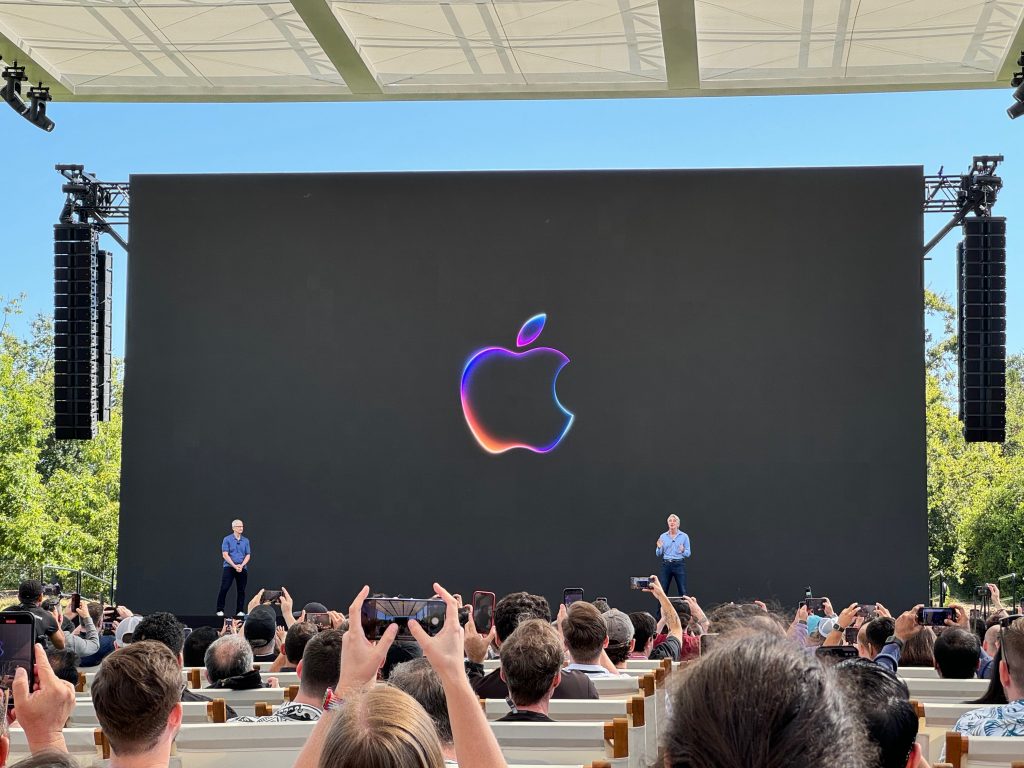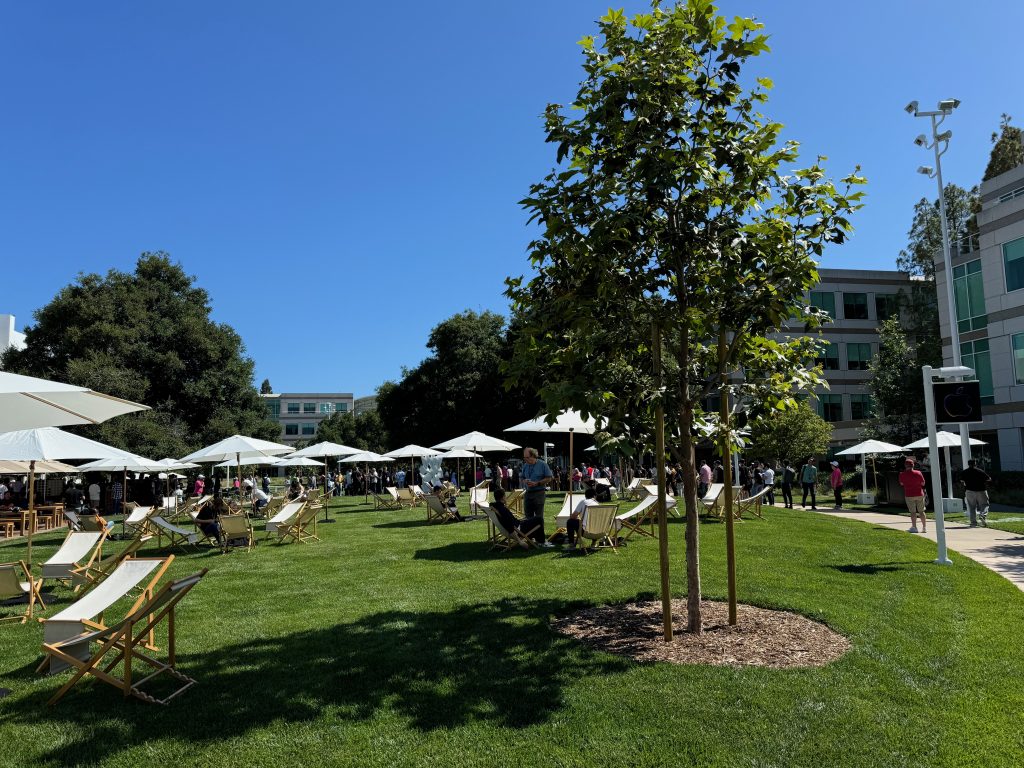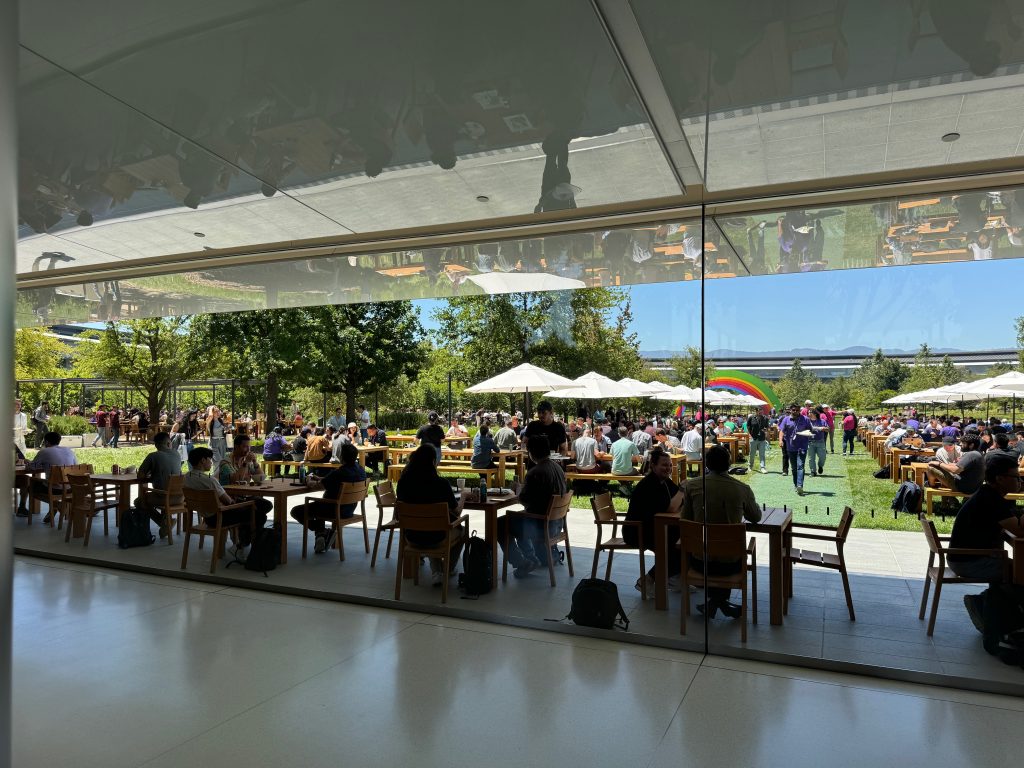
Last week, I attended the WWDC 2024 event in Cupertino. It took place in both the original Infinite Loop campus, as well as the Apple Park “spaceship” campus which opened in 2017 and cost $5 billion to build. Apple’s WWDC events are no longer a traditional developer conference. The developer session videos are all uploaded for free, and even the keynote is a prerecorded, so event attendees see it at the same time as the rest of the world. Instead, this is more of a social event – an opportunity to meet fellow developers, bump into some famous people, and take advantage of Apple’s hospitality. I found the event uplifting and exciting, and I was able to talk with many people and share perspectives with them.

Inside the Infinite Loop campus – rumors of a free bar may or may not be greatly exaggerated

The event was a great opportunity to share ideas and plans with other developers
Now, you might think that the event is solely for Swift developers, but this is not entirely true. Of course, Apple are constantly pitching their chosen language and frameworks at the event, but there is also a recognition that many people develop software for Apple platforms in tools other than Swift and Xcode. Of the people I spoke to, quite a number of people were using something other than Swift (including an Apple engineer!). Many of the sessions from WWDC are naturally catered towards Swift developers, but there are still some that will be useful to Xojo developers. I’ve highlighted a selection of videos below, along with my own description.
I want more stuff
When browsing WWDC videos, if you come across new functionality or an API that isn’t exposed in Xojo, the best course of action is to create a feature request at https://tracker.xojo.com. But don’t stop there. Tell the community about your request on the forum and ask them to give the request a “thumbs up” if they agree. This helps the Xojo team gauge interest. For some requests, you may also want to rope in support from me or one of the other MVPs, so that we can potentially engage with the team directly on your behalf at one of our regular meetings.
At each WWDC, Apple releases beta versions of its new tools and operating systems. These are very early versions, especially at this point in the beta cycle, and should not be installed on your main machines without very good reason. Early anecdotal evidence suggestions few problems with Sequoia (the new version of macOS) and Xojo apps, but testing such software should be done in virtual machines or on machines that you don’t use for your daily coding. When Xojo support for the new OS and the new version of Xcode becomes official, the System Requirements page will be updated at https://documentation.xojo.com/resources/system_requirements_for_current_release.html
Highlighted WWDC 2024 videos
“What’s new in App Store Connect”
Take better advantage of the App Store, get your app nominated for featuring and more.
“Add personality to your app through UX writing”
This is a quintessentially Apple presentation, but it may be thought provoking. What is the tone of your app? Does it matter for your market?
Self-explanatory from the title. Most of this will require the use of MBS plugins.
“Platforms State of the Union 5-Minute Recap”
The full State of the Union presentation, which follows the main keynote each WWDC, is rather lengthy and not required viewing for Xojo developers. But the five minute recap is worth watching to get an overview.
“Build multilingual-ready apps”
A lot of this video involves Swift code but there is still useful information for everyone in this.
Notes:
- Apple also have a “Expanding your app to new markets” document at https://developer.apple.com/localization/.
- To take advantage of much of this in your Xojo apps, see https://documentation.xojo.com/topics/localizing_your_apps/introduction_to_app_localization.html
SF Symbols (SF stands for San Francisco) is a library of thousands of clean and simple symbols for use in Apple platforms only. Apple typically updates this yearly.
Notes:
- To take advantage of SF Symbols in your iOS apps, use the Picture.SystemImage method. See the docs at https://documentation.xojo.com/api/graphics/picture.html#picture-systemimage
- There is no built-in support for SF Symbols in Xojo Mac apps, but you can still take advantage of them. See this blog post for details: https://blog.xojo.com/2021/10/21/quicktip-using-sf-symbols-in-macos-revisited/
- Tell Xojo that this support should really be built-in! Lend your support to this case; https://tracker.xojo.com/xojoinc/xojo/-/issues/60751
- Whilst SF Symbols is Apple-only, there is also a library of images built into Xojo for Android developments, also using the Picture.SystemImage method.
- Browse SF Symbols on your Mac (and get their names for use in Xojo) by downloading the SF Symbols utility from https://developer.apple.com/sf-symbols/
More videos
Want to watch even more videos? (Shouldn’t you be coding?) Subscribe to the official Xojo YouTube channel and also see videos from the recent Monkeybread Software conference, including presentations from Xojo engineers and other MVPs. https://www.youtube.com/@MonkeybreadSoftware/videos
Gavin is a Xojo MVP and is based in the UK. He has been a Xojo developer since the first version in 1998.
